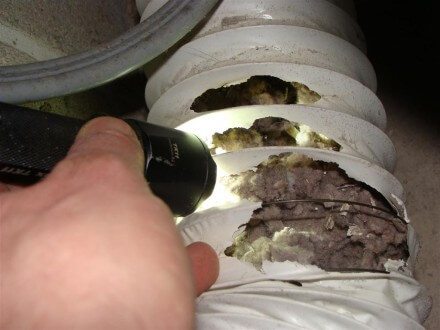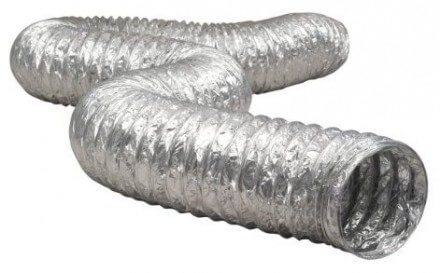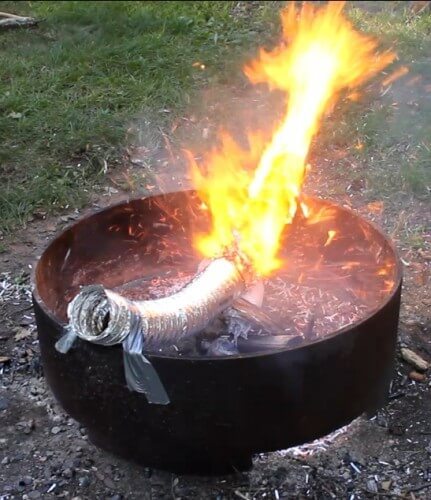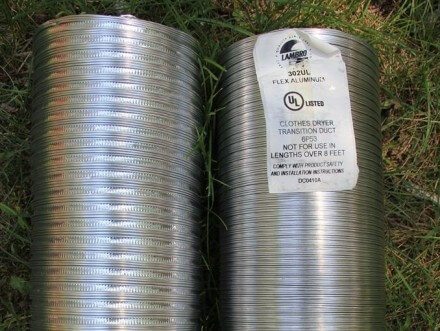Last week I blogged about clothes dryer ducts, and this week I’m going to follow up with information on dryer transition ducts. As I mentioned last week, a dryer transition duct is the flexible material that can be used to transition between the dryer and the duct. Transition ducts should be used sparingly, stretched tight, not smashed, and replaced periodically. They’re allowed by the Minnesota State Mechanical Code, but they can’t be any longer than 8′, and they need to be listed and labeled for the application. The key word is listed. If a dryer transition duct is listed, you’ll find the “UL” logo somewhere on the package or product.
Today I’ll discuss the three most common materials used for dryer transition ducts, and I’ll cover some basic rules for keeping your dryer transition duct safe.
Plastic Ducts
Plastic dryer transition ducts are a potential fire hazard. They’re never UL listed, they can get clogged with lint, and they’ll burn. If you have one of these, replace it. I looked for one of these at Home Depot and Menards, but I couldn’t find one. Good. I still find plenty of them while inspecting houses though.
I tried lighting some paper on fire inside one of these plastic ducts to see how fast it would burn through, and the plastic itself actually caught on fire.
Foil Ducts
Foil dryer transition ducts are typically UL Listed, and they’re readily available at any home improvement store. While these products are allowed by code, I’ve heard that many municipal inspectors won’t allow them, and most manufacturers of clothes dryers don’t recommend them either.
I tried burning one of the UL Listed foil ducts by filling it up with shredded paper, then lighting the paper. Once the paper caught fire, I accelerated the burn by aiming the blower end of a wet/dry vac at the tube. Some people claim that these foil ducts are flammable, but that’s not true; there are two versions of the foil dryer transition ducts – a listed and a non-listed version. That’s the listed version shown in the photo below. After heavy white smoke started pouring out the end, it took about 10 seconds for the flames to rip through the side.
Semi-Rigid Metal Ducts
Semi-rigid metal dryer transition ducts are available anywhere dryer duct materials are sold, but it’s almost impossible to find a UL Listed version of this. The strange thing is that these semi-rigid ducts seem to be universally accepted by building code officials, and they’re recommended by clothes dryer manufacturers. Everyone seems to like these, but they have their drawbacks: they puncture easily, they crush easily, they unravel easily, and they have very sharp edges. I repeat, very sharp edges.
After a ton of searching at local retailers and searching online, I couldn’t find a single UL Listed semi-rigid duct, so I concluded there was no such thing as a UL Listed semi-rigid metal duct.
But there is.
I sent out emails to several major clothes dryer manufacturers, asking what consumers are supposed to use for a dryer transition duct, because there doesn’t seem to be a UL listed semi-rigid duct. Finally, a very helpful person at Whirlpool by the name of Lee Herendeen sent me a link to just such a product, made by Lambro Industries, Inc. After all the searching I had been doing, I was skeptical that this was the real thing, so I ordered one. It’s the real thing.
The photo below shows the UL listed semi-rigid duct from Lambro sitting next to a non-listed duct.
The UL listed duct was much stiffer than the non-listed duct, and was much more difficult to crush. To continue my comparison of transition ducts, I stuffed them both full of shredded paper, lit the paper on fire, then aimed the exhaust from a wet/dry vac in to the duct to simulate the air from a clothes dryer.
I started with the non-listed duct.
At about the 40 second mark, heavy smoke started to come out the back side of the duct. About 17 seconds later the fire burned through the duct.
The next test was to try the same thing with the UL Listed duct.
With this one, heavy smoke started coming out at about the 30 second mark, and it took about 27 seconds for the fire to burn through the duct. Of course these aren’t ‘real life’ tests of a dryer duct fire, but it’s interesting to compare the performance of the different materials.
Conclusions
Don’t use plastic for your dryer duct. It’s flammable.
Foil comes in a UL Listed flavor and is easy to work with, but it’s prohibited by many building code officials and clothes dryer manufacturers.
Semi-rigid aluminum is good, but it’s a hassle to work with. If you’re going to use semi-rigid, use the UL listed version.
Next year I might check out a product called DryerFlex. They claim their product offers the best of both worlds. We’ll see.
Post edit 9/11/12: I tested it out, and it beat the pants off everything else. This is a far superior product. http://www.structuretech1.com/2012/09/dryerflex-a-superior-dryer-transition-duct/
Reuben Saltzman, Structure Tech Home Inspections









Reuben Collins
August 14, 2012, 8:29 am
Now I understand why your family doesn’t like to go camping with you. You spend the whole time burning dryer ducts. Also, the s’mores taste like dryer lint.
Charles Buell
August 14, 2012, 8:38 am
Reuben, awesome. This is why my dryer is steel pipe all the way 🙂 I have also wondered not only about the flammability or the burn-through issues but what about all the combustible materials the duct is in contact with? Since dryer fires are one of the leading causes of house fires I suspect we are going to see a lot more restrictive requirements about venting coming down the road.
Reuben Saltzman
August 15, 2012, 4:01 am
Reuben – now that you point this out, I know why too. Thanks for the tip 😉
Charles – steel is the way to go. You’re talking about clearance requirements like we have for furnace and water heater vents? I suppose that the first time a fire gets traced back to that, the requirements will change.
DryerFlex: A Superior Dryer Transition Duct | Structure Tech Home Inspections
September 11, 2012, 4:19 am
[…] – it’s called DryerFlex. I found this product while writing a recent blog post on dryer transition ducts, and I actually mentioned it at the end of that post. The DryerFlex dryer transition duct is a […]
Property Field Inspections
October 2, 2012, 11:14 pm
A transition duct is flexible, which allows the dryer to be joined to the duct and then pushed back up against a wall so it’s not sitting in the hub of the room.
Property Field Inspections
October 2, 2012, 11:26 pm
Home inspectors report will cover the condition of the home’s heating systems like central air conditioning system, interior plumbing and electrical systems, walls, the roof, windows and doors, the foundation, floors, basement and structural components.
Reuben Saltzman
October 3, 2012, 3:51 am
Hey Property Field Inspections – got any other nuggets of wisdom to share? Tell your SEO company they’re leaving dumb comments on blogs with your name attached.
Jason Harrison
April 6, 2013, 10:43 pm
Hi,
Thank you for your discussion. You state above “Transition ducts should be used sparingly, stretched tight, not smashed, and replaced periodically.”
What is your definition of periodically? Would you recommend examination of the interior and replacement if lint has accumulated?
I’ve found lint, dirt, sand, and paper staples in these ducts.
Reuben Saltzman
April 7, 2013, 5:23 am
Hi Jason,
I didn’t define periodically on purpose; examining the interior and replacing as needed would be the best course of action.
I’ve heard fire officials recommend replacing transition ducts annually, but my last house I had a 4′ section of dryer transition duct that stayed clean as a whistle for seven years, so I never replaced it.
Jason Harrison
April 7, 2013, 8:44 am
Thanks. I was examining my transition ducts last night. The installer (before we purchased the condo) had connected a flexible metal transition duct to the stacked washer dryer, directed it 90 degrees left out the side of the dryer, then to a 90 degree metal elbow to the back wall and switched to a metal foil transition duct to the back wall, up the wall, across the back of the top of the dryer to the wall duct in the ceiling (enters vertically).
The wall duct then makes a 90 degree degree bend to the left to run within the ceiling concrete slab to exit the building between floors of our tower.
Yikes!
We had installed an extra inline dyer blower fan a few years ago because of water build up in the building dryer duct. Lately I had noticed that clothes seemed to be taking additional time to dry. Thus the motivation for examining. I removed the flexible metal transition duct, the elbow, and mechanically cleaned out the flexible foil duct and use only it. As soon as I can I will replace it with a Dryer Flex transition duct.
peggy Purcell
May 22, 2013, 12:43 pm
On the third load of laundry, there is a hot, acrid smell that burns one’s eyes, and one’s throat feels constricted. I have a vent that goes to my garage roof, but it has been cleaned. Any ideas of what is causing this?
Reuben Saltzman
May 22, 2013, 2:23 pm
Hi Peggy,
No, I’ve never experienced that before.